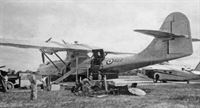Фотографии
-
Регистрационный номер: OB-R-200, KN368, OB-PAT-200 Douglas C-47B c/n 32737 served with the RAF as KN368 before being one of the first examples of the type acquired by Faucett in late 1946, with which it was registered OB-PAT-200. When Peruvian civil markings were reorganised in 1964, it was re-registered OB-R-200 before being taken on strength with the Peruvian Navy in 1967.
Самолёты на фотографии: Douglas DC-3 / C-47 Skytrain/С-53 Skytrooper / Dakota - США - 1935
-
Регистрационный номер: OB-PBC-248, OB-R-248 Built as a Douglas C-54A for the USAAF, c/n 10285 operated with Flota Aerea Mercante Argentina (FAMA) during 1946-50 and joined the Faucett fleet in late August 1950, re-registered OB-PBC-248. It remained with Faucett for a remarkable three decades, and is seen here at Limatambo in April 1963, before it was re-registered as OB-R-248 the following year.
Самолёты на фотографии: Douglas DC-4 / C-54 / R5D Skymaster - США - 1942
-
A view of the majestic Salcantay, the highest peak in the Vilcabamba mountain range, north-west of Cusco, from a port window of a Faucett airliner. Such unforgiving terrain is typical of the Peruvian landscape, and Faucett’s pilots were specialists in threading their way through the rugged Andes in unpressurised piston-engined airliners.
Самолёты на фотографии: Douglas DC-4 / C-54 / R5D Skymaster - США - 1942
-
By the late 1940s the Faucett airline was operating a comprehensive domestic network with a limited fleet of Douglas aircraft, including a DC-4, as depicted in the promotional item.
Самолёты на фотографии: Douglas DC-4 / C-54 / R5D Skymaster - США - 1942
-
The cover of a July 1949 Faucett timetable showing the locations served by the airline’s services, from Tumbes on Peru’s northern Pacific coast to Iquitos, deep in the Amazon rainforest to the east, and from Tacna on Peru’s border with Chile in the far south to Cusco in the Andes and the capital Lima.
Самолёты на фотографии: Douglas DC-4 / C-54 / R5D Skymaster - США - 1942
-
Самолёты на фотографии: Douglas DC-4 / C-54 / R5D Skymaster - США - 1942
-
Регистрационный номер: OB-R-750 Faucett ultimately operated a fleet of six Douglas DC-6s. This example, OB-R-750, joined the fleet in November 1964, converted into a dedicated cargo aircraft; note the lack of cabin windows and the large door in the rear fuselage for freight operations. It is seen here at Miami in April 1979.
Самолёты на фотографии: Douglas DC-6 / C-118 Liftmaster - США - 1946
-
Регистрационный номер: OB-FAA-344, OB-OAA-134 In March 1943 two PBY-5A Catalinas were leased to Faucett by the Rubber Development Corporation. This example (c/n 906; the other was c/n 907) was registered OB-FAA-344 on March 16, was re-registered OB-OAA-134 in November 1944 and was ultimately acquired by the Cuerpo de Aviacion del Peru as serial 422, as seen here.
Самолёты на фотографии: Consolidated PBY Catalina - США - 1935
-
An early luggage label of the fledgling Compania de Aviacion Faucett, established in 1928, featuring a stylised illustration of the company’s sole Fairchild FC-2W. Initial operations by the airline were undertaken with the FC-2W and a two-seat Curtiss Oriole biplane. In 1928 Faucett supplemented this tiny fleet with a pair of Stinson Detroiters.
Самолёты на фотографии: Fairchild FC-1 / FC-2 - США - 1926
-
Регистрационный номер: OB-R-953 In 1971 Faucett received the first of its BAC One-Eleven Series 475s, OB-R-953, seen here. Another, OB-R-1080, arrived in 1974 and a Series 523, OB-R-1137 (later OB-R-1173), in 1977. These were used on domestic routes, often to gravel strips in mountainous terrain, for which the Series 475 had been specifically developed.
Самолёты на фотографии: BAC BAC.111 One-Eleven - Великобритания - 1963
-
Регистрационный номер: OA-BBI [2] The prototype F-10, OA-BBI, was painted a vivid orange, to make it easily visible should it have to make a forced landing in the jungle, and given fleet number 9. The prototype, actually a much modified Stinson SM-6B, made its maiden flight on September 20, 1934, in the hands of the company’s chief test pilot, Gale Alexander.
Самолёты на фотографии: Faucett-Stinson F-10 / F-19 - Перу - 1934
-
Регистрационный номер: OA-BBQ During March-April 1937 Lt-Col Armando Revoredo Iglesias made a much-celebrated long-distance flight from Lima to Buenos Aires in Argentina and back in F-10 OA-BBQ/No 17, seen here at Santa Cruz airfield beside other Faucett aircraft sometime after 1940, when the OB- registration prefix replaced the previous OA- prefix.
Самолёты на фотографии: Faucett-Stinson F-10 / F-19 - Перу - 1934
-
In 1934 Faucett’s engineering department began work on developing a larger, stronger and easier to maintain version of the Stinson SM-6B, resulting in the Faucett F-10, of which a total of 12 was built. This head-on shot of an F-10 at the company’s Santa Cruz airfield in December 1936 shows its robust wide-track undercarriage.
Самолёты на фотографии: Faucett-Stinson F-10 / F-19 - Перу - 1934
-
Регистрационный номер: OA-BBI [2] A group of ladies pose with Elmer Faucett (in cockpit) beside the first Faucett F-10, OA-BBI, fitted with a distinctive forward-raked windscreen, a design feature much in vogue in the mid-1930s; the benefits of such an arrangement have long been a subject of discussion, and probably made little or no difference to performance.
Самолёты на фотографии: Faucett-Stinson F-10 / F-19 - Перу - 1934
Статьи
- -
- B.Cahill - The original photo bombers
- E.Young - American aviators in Japan (1)
- J.-C.Carbonel - France's Air Pioneers: Jean de Chappedelaine (again)
- K.Hayward - The Westland affair
- L.Hellstrom - The world's smallest fighter force
- M.Hiscock - A missed opportunity?
- M.Russell - A question of calibre
- M.Wickstead - "Faucett"
- N.Stroud - Canada's ice patrol
- P.Davidson - Off the Beaten Track...
- P.Jarrett - Lost & Found
- P.Jarrett - Monsieur Delprat's Flying Summerhouse
- P.Lewis - Hunter 80 (1)
- R.Pegram - The golden age?
- T.Withington - Victor/Martel. From V-bomber to wild weasel?













